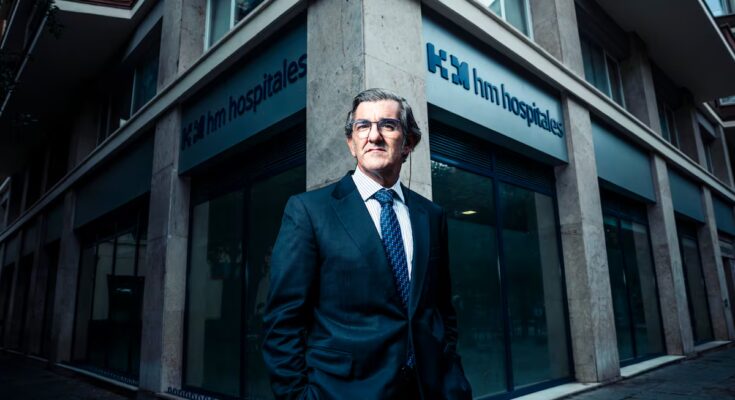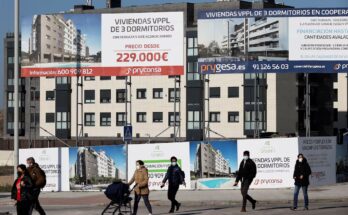Juan Abarca Cidón (Madrid, 1971) has been president of HM Hospitales since 2016. The company has reached 719 million euros in turnover in 2024, with a staff of 7,400 people, 2,012 beds and 148 operating rooms. Now it is developing new plans, in a sector such as private healthcare which already has 13 million insured people, with the promotion of research and teaching areas, and under the artificial intelligence (AI) revolution.
Ask. HM Hospitales recorded growth of more than 8% in 2024. What are your prospects for 2025?
Answer. 2024 was a good year because there was a growth in presence, complexity and we continue to grow especially in the two territories in which we have been present for the shortest time, which are Catalonia and Malaga. I would say we are on a ramp, we are growing, but this year it won’t go as well. In billing we will continue to grow at a similar pace, but not in ebitda, which is the important thing, because the increase in human resources, energy or food costs is not compensated by the increase in tariffs. Ebitda will rise slightly, but less than turnover.
Q. How do you see the industry as a whole?
R. A phenomenon is occurring in private healthcare. People with complex pathologies, for example public employees, after the mutual benefit crisis, moved to the public sector, which for us reduces the complexity. It was also a relatively healthy year from a flu perspective, which means a little less attendance. Policies with few benefits are also proliferating, and the number of insured people continues to increase, by 3%, but there are already 13 million. In Spain there are not 13 million Spaniards who earn more than 60 thousand euros, far from it.
Q. Are we reaching the limit?
R. The sector continues to grow, but the time will come when we will have to realize this, because not everyone can afford an additional expense, especially when you have a public healthcare system which, in principle, is universal. What happens is that the problems of accessing the public system are so serious that people have no other alternative. No one can wait a year for a diagnosis, as is happening in some autonomous communities. This situation reduces our complexity, and if it is reduced, billing decreases. This goes against a myth that we don’t want complexity, that we don’t care. That’s not true, the higher the complexity, the higher the billing. We deal with all policies and carry out social work to relieve the public health sector, even if that is not what we are interested in.
Q. How does HM handle this scenario?
R. Our model is very customized. We don’t have managers, we have medical directors and management is centralized. We want to have more management synergies and healthcare synergies, which are what differentiates our model. With management synergies, purchases and tariffs are better negotiated; But with healthcare, complex patients are centralized, which results in better machine payback and better health outcomes.
Q. He spoke about Catalonia and Malaga. Will there be new openings? Do you plan to enter other areas?
R. We will continue to bet on these sectors. We don’t buy hospitals if we don’t have the ability to generate healthcare synergies, it doesn’t make sense. This is why we collaborate with 10 hospitals in Madrid, four in Galicia and three in Barcelona, where we will build a new one, Sant Cugat, and have another replacement. In Malaga we started with four and we are building two more, one in Vélez and another which will be our large hospital in Malaga, in the center of the city. In principle, today we do not plan to enter more areas because our model is based on networking, not on having isolated hospitals.
Q. How has your position in Madrid evolved?
R. In Madrid we are building the Tres Cantos Hospital, equipped with a residence; and we just opened HM Nuevo Norte, in Las Tablas. HM Tres Cantos is scheduled to open in the first half of next year. In the Community of Madrid we are leaders in the private sector, we carry out 15% of all healthcare activity, almost 600,000 emergencies. This framework allows us to accumulate many patients and not only guarantee quality care, but also have a portfolio of services that no one in the private sector in Spain has. In terms of complexity we compete with any public hospital.
Q. The company has made a strong commitment to teaching. What goals does he have?
R. Teaching and research are essential. We have been university students since 2004 and Montepríncipe was the first private center in the Community of Madrid to be accredited as a university university. We have all the degrees in health sciences and we have our Institute of Biohealth Professions. And we are replicating this model in all our territories. The research activity was started in 2003, with the Research Foundation, which operates cohesively with all the hospitals. For us they represent a lever to attract talent and support our objective of adding value to the Spanish healthcare system.
Q. What are the strongest sectors in research?
R. I am thinking of oncology, clearly. We are one of the most powerful oncology groups in this country. In neuroscience, we have the Global Neuroscience Center, in Móstoles, which is a leader in Parkinson’s disease, Alzheimer’s and brain tumor treatment. We also have research in cardiology, vaccines and other areas.
Q. Nowadays everything is AI, how is HM adopting this technology?
R. This is undoubtedly a revolution and will transform the industry from top to bottom. HM wants to lead this change, which will be very complicated, because at a health policy level it will be difficult for it to become reality. Furthermore, it requires new professional profiles. We already use AI in multiple ways, both from a clinical perspective, in screening and efficiency for patients, and from a non-clinical perspective. It is widely used to provide security to our radiologists and pathologists, because it helps in the analysis of tests and diagnoses. It must be a tool to make us much more productive and efficient. Ultimately AI will know much more than doctors and will be much more up to date, but people need to be explained that empathy with patients is much more important.
Q. What is the structure of HM? Have you ever thought about going public on the stock exchange?
R. This is a family business. It is a joint-stock company in which the family holds 90% of the capital. The rest is a minority shareholder and the company’s workers. Today we are not in that phase, we are in the growth and consolidation phase. This is a personal project started by my parents and now my brothers and I continue. Our goal is to continue to consolidate our growth and we have many plans until 2030.



